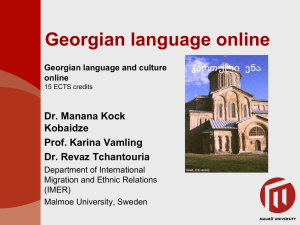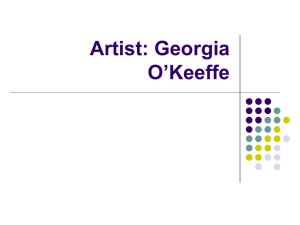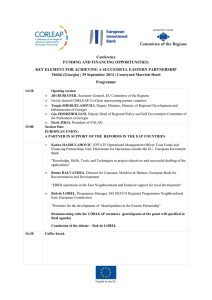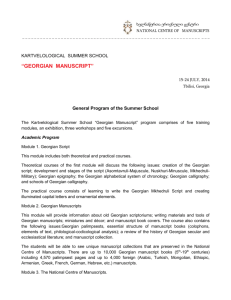Georgian Economy Overview
advertisement
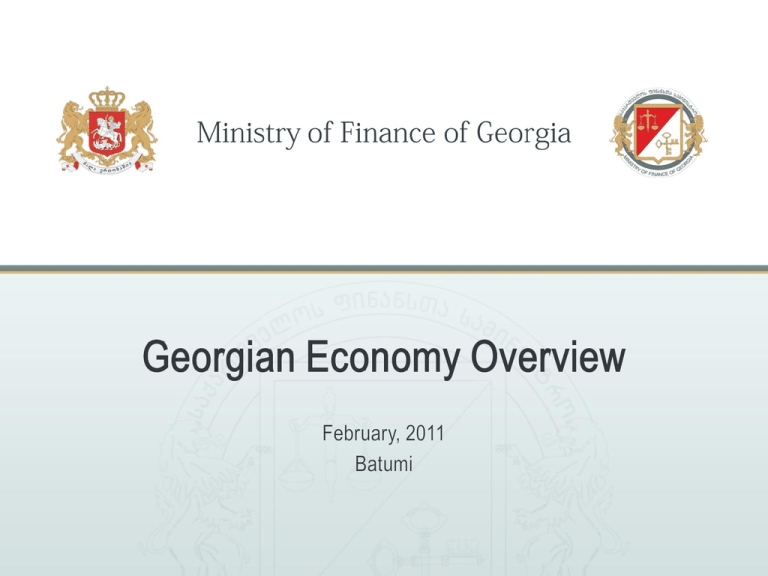
Georgian Economy Overview February, 2011 Batumi Reform Driven Economic Success GDP Nominal GDP (US$bln) 17 15 13 11 9 7 5 3 1 -1 Real GDP growth, y-o-y (%) 15% 12.3% 11.1% 16.0 9.6% 12.8 9.4% 2003 2004 2.3% 2005 2006 2007 40% 33.7% 2008 30% 10,000 31.2% 29.9% 25.8% 27.5% 20.1% 8,000 -3% 2010E 7,940 7,635 7,126 7,084 6,670 6,920 5,719 3,947 1,977 1,446 10% 2005 2006 2007 2008 2012F -6% 2013F 2005 2006 2007 2008 2009 Initially Planned (2009E) 2010F 2011F -6% -8% -10% 2012F 2013F 0.0% -2.3% -2% 4,000 - 2004 0% -4% 2,000 0% 2003 2011F Fiscal Deficit as % of GDP - Current Path 6,000 16.9% 2,993 20% 3% Conventional Fiscal Deficit 34.6% 28.6% 5.5% 0% 2009 Expenditures (Capital + Current) as % of GDP 36.3% 37.2% 4.5% 6.5% -3.9% General Budget Outlays Expenditures (Capital + Current) 9% 6% 5.5% 7.8 6.4 5.1 4.0 10.7 10.2 5.9% 12.7 11.4 12% 14.2 -2.6% -2.9% -4.3% -3.4% -4.8% -4.8% -4.0% -6.3% -7.3% -6.5% -9.2% 2009 2010F 2011F 2012F 2013F Georgian Economy Overview 2 Strategic Infrastructure Projects with Significant Positive Externalities and Strong Spillovers into the Rest of the Economy • • • • Energy Infrastructure Black Sea 500 kv. Regional Power Transmission Line →US$ 350 million HPPs – Khudoni, Namakhvani, Nenskra Cascade etc. (additional installed capacity of 2000 MW, to be implmented till 2018) Underground Gas Storage Facility FIZ – Trade and Logistics Infrastructure Poti FIZ Kutaisi FIZ Railway Infrastructure Tbilisi By-Pass Project → US$ 270 million Roads Infrastructure East-West Highway Improvement Project → upto US$1 billion Adjara Bypass Road → US$ 240 million Vaziani-Gombori-Telavi Road → US$ 30 million South Georgia Road → US$ 200 million • Secondary and Local Roads → US$ 70 million Communal Infrastructure Regional Municipal and Urban Infrastructure Development Projects → US$ 500 million Water and Sanitation Restructuring and Rehabilitation → US$ 600 million Georgian Economy Overview 3 Major Diversified Investment Inflows FDI Breakdown of Remittances ‘09 US$ million Russia 417.9 54.5% USA 65.4 8.5% Greece 58.9 7.7% Ukraine 52.6 6.9% Turkey 20.6 2.7% 20.4 2.7% Germany 8.1 1.1% Israel 8.1 1.1% Spain Other Countries 114.5 766.5 Total 14.9% 100.0% Net Cumulative FDI Breakdown by Origin (‘04-’09) Country UAE UK Netherlands Turkey USA British Virgin Islands Kazakhstan Czech Republic Cyprus Bahamas Subtotal Other Total Cummulative Net FDI, '04-'10 Share in Total US$ million 696 678 597 581 445 414 310 294 259 214 4,488 1,872 6,360 Georgian Economy Overview Share in total 10.9% 10.7% 9.4% 9.1% 7.0% 6.5% 4.9% 4.6% 4.1% 3.4% 70.6% 29.4% 100.0% 10,000 Net FDI as % of GDP 19% 16.5% 15.3% 17% 8,000 15% 11.7% US$ mln Country 6,000 9.4% 13% 8.5% 6.1% 4,000 5,379 2,000 6,038 7.0% 6,808 11% 8.1% 9% 7% 7,808 5% 3% 3,885 483 1,025 2004 2005 2,211 1% 0 -1% 2006 2007 2008 2009 2010E 2011F FDI Breakdown by Sectors (2009) Other 7% Agriculture 3% Transport & Communicatio ns 15% Financial Sector 8% Construction 16% Industry incl. Energy 21% Real Estate 22% Services 8% 4 Dynamics of Brussels Pledge ($4.5 billion) Implementation Brussels Pledge Update – Public & Estimated Private Sectors Commitments by Sectors Various 6% Direct Budget Support 21% Private Sector 21% DISBURSED ~$2.0 Billion COMMITTED PLEDGED ~$4.0 Billion $4.5 Billion Commitments (signed) so far by Donors, Public Sector Operations Japan Other EIB 7% 1% 5% WB 18% Germany 8% EC 9% Georgian Economy Overview Transport Infrastructure 21% Key Facts As of end November 2010, Georgia had entered into contractual commitments for and/or received up to 90% of the total Brussels pledge ADB 17% EBRD 9% USG 26% Urban and Municipal Infrastructure 10% Energy Infrastructure 13% IDPs 8% By end of H1 2011, the Brussels Pledge to Georgia will likely have been processed in its entirety, with possibility of further upward adjustment in the outer months of 2011 and beyond Absorption of committed funds into the economy will continue through several years, boosting economic activity and generating jobs 5 Favorable Public Debt Situation Debt Indicators: Below the Prudential Threshholds Public Debt Stock Total Public Debt to GDP (%) External Public Debt to GDP (%) External Debt to GDP (%) 87.6% 80.6% 82.0% 80% 48.9% 32.0% 46.9% 44.8% 4,000 41.8% 3,000 31.8% 20% 21.1% 46.3% 31.2% 25.5% 6,000 37.2% 38.5% 36.6% 34.0% 60 0 0 2006 2007 2008 2009 2010F 2011F 2012F 105.7 63.8 19.1 20 10.1 2,000 16.8% 0% Yield 40 1,000 23.5% Price 96.0 80 5,000 41.2% 40% 70.9% 100 US$ bln 60% 76.2% 60.9% 56.8% 120 7,000 2013F 5.04 Jul-08 Aug-08 Sep-08 Oct-08 Nov-08 Dec-08 Jan-09 Feb-09 Mar-09 Apr-09 May-09 Jun-09 Jul-09 Aug-09 Sep-09 Oct-09 Nov-09 Dec-09 Jan-10 Feb-10 Mar-10 Apr-10 May-10 Jun-10 Jul-10 Aug-10 Sep-10 Oct-10 100% Eurobond Performance: Incremental and Sustained Improvement Flat Repayment Profile: Government External Debt Service as % of Exports 20% as % of Budget Revenues 19.0% Eurobond US$ mln 15% 10% 9.1% 8.8% 7.1% 5% 6.4% 4.6% 3.4% 5.1% 6.0% 2004 2005 2006 Georgian Economy Overview 2007 7.5% 7.8% 4.1% 3.9% 4.0% 2014F 2015F 2016F 11.0% 4.7% 5.0% 5.3% 2.3% 4.6% 4.1% 4.1% 2.6% 2009 2010F 2011F 2012F 3.9% 2.1% 3.2% 0% 2003 8.3% 7.3% 2008 2013F 6 Favorable Public Debt Situation External Public Debt by Interest Type: Interest Rate Risk Brought to a Minimum Affordable Public Debt Stock and Very Low Interest Rate on External Public Debt (in million USD) Multilateral 57% External 3,754 79% Domestic, 1,011 , 21% Portfolio Average Weighted Interest Rate as of end-October 2010 Bilateral 12% Eurobond 10% Variable 30% Fixed 70% 2.1% Government External Debt Amortization Profile: Flat Trajectory, Easily Affordable Annual Repayment Volumes IMF EUROBOND Georgian Economy Overview 2030 2029 2028 2027 2026 2025 2024 2023 2022 2021 2020 2019 2018 2017 2016 2015 2014 2013 2012 2011 Refinancing limited to 2013, the bulk of Gov’t external debt owed to official development creditors on concessional terms 2010 US$ mln OTHER LOANS 800 700 600 500 400 300 200 100 0 7 Domestic Debt Market Performance 12 Months T-Bills Discount Rates 6 Months T-Bills Discount Rates 6 Months T-bills 12 Months T-bills 14% 16% 14% 9.3% 10% 11.4% 6.9% 8% 6% 4% 4.5% 4.1% 2% Discount Rate 12.0% 8.5% 10% 6% 4% 0% Cumulative Issuance by Instrument T-Notes T-Notes 400 14.8% 15.6% 350 Aug-10 Sep-10 280 220 85 130 80 0 Sep-09 Georgian Economy Overview 25 Jul-10 10 Jun-10 0 May-10 10 Apr-10 0 50 Mar-10 275 150 342 200 377 250 100 Feb-10 6M T-Bills 300 10.3% 10.2% 12M T-Notes 190 14.3% GEL mln Coupon Rate 6.0% 5.2% T-Notes Coupon Rates 17% 16% 15% 14% 13% 12% 11% 10% 9% 8% 7.7% 8% 2% 0% 14.6% 12% 70 Discount Rate 12% Dec-09 Mar-10 Jun-10 Sep-10 8 FC Sovereign Ratings Chronology Georgian Economy Overview 9 Current Account Current Account Deficit Trade Balance (GEL mln) -5,000 -4,000 -9.6% -6.9% -30% -22.8% -19.8% -15.1% -11.1% CAD as % of GDP -11.8% -11.3% -10.2% -20% -10.0% -8.9% -10% -3,000 0% -2,000 -3,812 10% -2,735 -1,000 -2,066 -1,862 -2,403 -2,339 -2,214 20% -1,130 -846 -577 -2,240 0 30% 2003 2004 2005 2006 2007 2008 2009 2010F 2011F 2012F 2013F Offsetting Inflows Portfolio Investments and Other Capital Inflows 2,500 Remitances FDI 2,062 984 599 1,533 937 563 1,120 892 548 591 859 728 658 1,119 766 2008 1,564 918 1,750 755 2007 748 1,170 420 493 453 315 252 492 213 38 335 500 166 1,000 1,585 1,500 40 US$ mln 2,000 0 2003 2004 2005 Georgian Economy Overview 2006 2009 2010F 2011F 2012F 2013F 10 Regional Energy Hub Reliable transit country and regional energy hub – Baku-Tbilisi-Ceyhan (BTC) oil pipeline – Baku-Supsa oil pipeline – South-Caucasus gas pipeline (SCP) from Shah-Deniz – North-South Gas pipeline – Georgia-Azerbaijan Southern Gas (GASP) AGRI Gas supply contracts with Azerbaijan for 10 years and with Shah Deniz for 20 years Transit role for oil & gas – pipelines and railway – Circa 1.6% of world oil production LNG across Black Sea – Azerbaijan-Georgia-Romania Interconnection (AGRI) project initiated by three states together with NABUCCO/White Stream – huge potential to transport gas from the Caspian to Europe The only country in the region (which doesn’t have its own gas resource) that was not effected by gas crises in January 2009 Georgia/Romania MoU for transportation of carbon resourses from Caspian via Black Sea Georgian Economy Overview 11 Net Electricity Exporter with Significant Export Expansion Capacity Net Electricy Exports: Fast-growing Source of Export Revenues • Huge, rapidly growing consumption rate and high tariffs on the Turkish electricity market expandable to Iraq, Syria and EU countries Net Exports 1.5 1 tw/h 0.5 0 -0.5 2004 2005 2006 2007 2008 2009 2010 • Net electricity exporter in all four neighboring countries since 2007 • Net exports for 2010 (1 TWH) 5 times higher compared to Year 2007, aiming to double by 2013 (2 TWH) • New hydro projects awarded with installed capacity of 2000 MW and potential export capacity of 6 TWH by 2018 -1 • Construction of 500 and 154 KV power transmission line to Turkey -1.5 • Additional new 500 KV interconnection to Turkey is under negotiation • 5 new HPP projects under construction with installed capacity of around 170 MW (7MW, 46 MW, 78 MW, 5 MW and 36 MW), additional 2000 MW of installed capacity to be assembled until 2018 (Namakhvani, Khudoni, Nenskra etc), boosting annual exports to $300 million by 2018 • Huge untapped hydro resources • Only 18% of the country’s hydro potential utilised so far Georgian Economy Overview • Once all three electricity lines are operational, total transmission capacity to Turkey will reach more than 2000 MW - 15 times more than current capacity 12 Export Driven Agriculture Development Agriculture Export: Expanding to Large New Export Markets Sheep Export: Highly Demanded in the Middle East 300,000,000 300,000 285,621,244 275,171,981 280,000,000 250,000 200,000 Units USD 260,000,000 240,000,000 267,144 237,494,100 227,841,855 150,000 100,000 220,000,000 50,000 0 200,000,000 2006 2007 2008 2006 2009 Hazelnut Export: Stronger Than Ever 20,000 2008 2009 3,747 3,000 MT 11,700 MT 2007 21,000 4,000 16,000 12,000 10,805 Culinary Herbs Export: Steadily Fast-growing 17,650 12,800 85 7,900 1,841 2,000 1,349 8,000 1,000 4,000 279 0 0 2006 2007 2008 Georgian Economy Overview 2009 2006 2007 2008 2009 13 Diversification of Agriculture Export: New Markets for Traditional Export Products Geographical Distribution of Wine Export in 2005: before Russian Embargo Ukraine USA Others Geographical Distribution of Wine Export in 2009: Substantial Diversification Benefits Achieved Azerbaijan Kazakhstan Others USA Litva Azerbaijan Kazakhstan DIVERSIFICATION Litva Russia Ukraine Geographical Distribution of Mineral Water Export in 2005: before Russian Embargo USA Ukraine Others Azerbaijan Geographical Distribution of Mineral Water Export in 2009: Substantial Diversification Benefits Achieved Belarus Kazakhstan Others USA Latvia Azerbaijan Belarus Kazakhstan DIVERSIFICATION Russia Georgian Economy Overview Ukraine Poland Latvia 14 Georgia, the Increasingly Global Tourism Destination Rapidly Growing Tourist Arrivals 2,000,000 1,800,000 1,600,000 1,400,000 1,200,000 1,000,000 800,000 600,000 400,000 200,000 2000 2001 2002 2003 2004 2005 Rebranding Georgia as tourism destination on international arena 2006 2007 2008 2009 2010 Annualized and transforming Georgia into regional tourism hub in the Caucasus Growth effects of the domestic road interconnectedness compounded by“vertical” approach to the revival of Georgia’s traditional tourism hubs (Tbilisi, Mtskheta, Batumi, Bakuriani, Gudauri etc.) and (re)discovery of new promising destinations (Svaneti, Anaklia, Signaghi, Kvareli etc.) capable of providing tremendous lasting boost to sea and mountain tourism, to ‘wine tours’ and green tourism. Domestic tourism development – area with significant unexplored growth potential Kobuleti and Anaklia Free Tourism Zone (plot of land for symbolic GEL 1 price, customized profit and property tax exemptions) Cultural sites inscribed on the UNESCO World Heritage List Georgian Economy Overview 15 ShiftingTowards Sustainable External Position Georgia’s Competitive Edge According to the IFC – Most Promising Sectors with Large Export Potential and Job Generation Capacity WINE, NUTS, FRUIT, VEGETABLES AND HERBS PHARMACEUPTICALS AND MEDICAL SERVICES Ideal growing conditions for wide range of grapes, fruit and vegetables Georgia already ranks among top 5 global exproters of Nuts Competetive factor costs Proximity and duty-free access for serving EU and CIS markets Large base of people with experience in sector Large and growing regional market in Caucasus and Central Asia, with virtually no local medical manufacturing capacity 3 Existing manufacturers Good location and skill base, low labor costs and strong business environment Natural entry/exit point between Caucasus, Central Asia and rest of world Logistics and transport services hub for the region: inbound/outbound shipping, rail and road services; aircargo hub; transshipment and intermodal hubs, etc CONSTRUCTION MATERIALS PRIMARY PROCESS INDUSTRIES APPAREL Very competetive factor costs: wages, real estate, transport, taxes and business environment Transport links and GSP+ access to EU, world’s largest apparel market Educated workforce with experience in apparel industry Georgian Economy Overview Low labor costs Raw material supply Large and growing regional market Excellent transport links with neighbouring countries LOGISTICS / TRANSPORT SERVICES Oil and gas pipelines, energy supply, mineral deposits, existing metallurgy cluster Favorable business environment Position as gateway to/from Caucasus/Central Asia 16 One of the Best Low-Tax Jurisdictions ‘04A ‘05A ‘06A ‘07A ’08A ‘09A ’10A ‘11F ‘12F ‘13F 21 7 7 7 6 6 6 6 6 6 VAT 20% 20% 18% 18% 18% 18% 18% 18% 18% 18% Income Tax 1220% 12% flat 12% flat 12% flat Social Tax + Income Tax 32% 25% Social Tax + Income Tax 20% Social Tax 33% 20% 20% 20% - Corporate Profit Tax 20% 20% 20% 20% Dividend & Interest Income Tax 10% 10% 10% 10% Number of Taxes 20% 20% 18% 15% - - - - - 15% 15% 15% 15% 15% 15% 10% 5% 5% 5% 3% 0% No payroll tax or social insurance tax No capital gains tax No wealth tax, inheritance tax or stamp duty Foreign-source income of individuals fully exempted Tax rates reduction timetable has been further accelerated in 2008 Georgian Economy Overview 17 Tax Administration Monthly Declaration Statistics Compliance Facilitation and Services Robust e-filing and e-payment systems Unified Cards for Customs and Tax Liabilities Princple of “Good Faith” Special Treatment of Micro and Small businesses Electronic VAT Invoices Electronic Administration System • Risk Based Selection of Taxpayers for Control • Electronic Assignments for Tax Officers • Electronic Performance Monitoring Risk Based Tax Audit Advance Ruling Accelerated Services Personal Tax Agent Number of e-filings Number of hard copy declarations 250,000 200,000 150,000 100,000 50,000 - e-filing: Number of Registered Users e-filing vs. hard copy declarations Number of Registered Users Share of e-filing Share of hard copy declarations 100.0% 150,000 130,000 110,000 90,000 70,000 50,000 30,000 10,000 -10,000 80.0% 60.0% 40.0% 20.0% 0.0% Georgian Economy Overview 18 Special Taxation Regimes Adopted • Special taxation systems have been adopted for the different regimes aimed at establishing new international financial institutions in the country, encourage economic growth, support sustainable development and the trade-transit function of Georgia Type of Tax An International Financial Company Free Industrial Zone Free Warehouse Company Corporate Income Tax (from financial services) 0% (for International Companies) 0% (from re-exporting of foreign goods) 0% 0% 0% 0% Customs Tax 0%, 5% or 12% 0% 0% Property Tax up to 1% 0% up to 1% 20% 20% 20% Value Added Tax Personal Income Tax Georgian Economy Overview 19 One of the Best Performer by Forbes Tax Misery & Reform Index According to 2009 Tax Misery & Reform Index, release by Forbes Business & Financial News, Georgia is the fourth least tax burden country after Qatar, UAE and Hong Kong Since 1 January 2009, income tax declined to 20% from 25% Georgian Economy Overview 20 Top Reformer Over the Past 5 Years According to the World Bank – IFC Doing Business Report Georgian Economy Overview 21 Reforms - Creation of Favourable Market Environment Ease of Doing Business, 2011 (WB-IFC Doing Business Report) Economic Freedom Index, 2010 (Heritage Foundation) 8 4 USA UK Up from 5 11 USA UK 8 Norway 16 Estonia 112 in 2005 12 GEORGIA 26 GEORGIA 17 Estonia 50 Latvia 54 Azerbaijan 51 Hungary 48 Armenia 63 Romania 51 Bulgaria 64 France 56 Romania 67 Turkey 65 Turkey 74 Italy 59 Kazakhstan 75 Bulgaria 66 Montenegro 82 Kazakhstan 68 Belarus 96 Azerbaijan 89 Serbia 143 Russia 123 Russia 162 Ukraine 145 Ukraine TI 2010 Global Corruption Barometer: % addmitting having paid a TI 2010 Global Corruption Barometer: % of the surveyed claiming bribe within the last 12 month the corruption level has decreased GEORGIA 78% 1% United Kingdom 26% Poland 3% GEORGIA 26% Turkey 4% Canada 14% Japan 5% United States 14% Czech Republic 5% Spain 9% Austria 5% EU+ Georgia ranks 1st in the 9% 7% Latvia France 8% 9% world in terms of the Lithuania Austria 9% 7% Japan France (public perception of the) 13% 6% Italy United States decrease of the level of 14% Czech Republic 5% Italy 15% Poland 4% Canada corruption 15% Latvia 3% United Kingdom 28% Romania 3% Spain 33% Turkey 3% EU+ 34% Lithuania 2% Romania Georgian Economy Overview 22 Investing Across Borders - Indicators of Foreign Direct Investment Regulation According to the World Bank Sector GEORGIA Score Regional Average Global Average Mining, oil & gas 100 96.2 92 Agriculture & forestry 100 97.5 95.9 Light manufacturing 100 98.5 96.6 Telecom 100 96.2 88 Electricity 100 96.4 87.6 Banking 100 100 91 Insurance 100 94.9 91.2 Transport 100 84 78.5 Media 100 73.1 68 Construction, tourism & retail 100 100 98.1 Health care & waste management 100 100 96 “Georgia is one of the most open countries to foreign equity ownership as measured by the Investing Across Sectors indicators. All of the 33 sectors covered by the indicators are fully open to foreign investment. There are neither sectors with monopolistic or oligopolistic market structures nor any perceived difficulties in obtaining any required operating licenses” – Summary by the World Bank Georgian Economy Overview 23 Fundamental Policies: What We Believe In • The rule of law & property rights • Minimal state fiscal footprint • Few, low and flat taxes • Minimal social security burden on businesses • Sound money • Inflation targeting, single-digit inflation • Free trade • Flexible labour market, with minimal state interference in employer-employee relations • Limited government • Deep de-regulation • Dramatically minimized and simplified licensing • Aggressive privatisation • Means-tested, focused state assistance to the poor • Lean and efficient civil service sector – providing value for taxpayers’ money Georgian Economy Overview 24 Fundamental Policies: Ensuring No Policy Drift • Fiscal responsibility – – – – Government expenditure capped at 30% of GDP Budget deficit capped at 3% of GDP Government debt capped at 60% of GDP No budget earmarks Deviation from these threshholds would be possible under the negative GDP growth conditions, but the Government would be required to develop a plan aimed at reverting these ratios within three years from the breach • Since 1995, no restrictions on currency convertibility or repatriation of capital & profit • Ban on state ownership of banks and on the imposition of price controls – No state-owned banks since 1995 and no price controls since the early 1990s • Ban on an increase in the number of licenses and permits • Ban on an increase in the number of state or independent regulators – Currently, independent regulators exist only in financial services, communications and utilities • Means-tested assistance rendered through vouchers and other ways that empower citizens and give them choice (in healthcare, education, etc), rather than by funding directly state-owned service providers Georgian Economy Overview 25 Contacts Kakha Baindurashvili Minister of Finance of Georgia +995 32 261 444 k.baindurashvili@mof.ge Georgian Economy Overview 26


